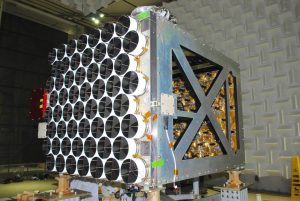
Credit: NASA
Launched June 3, 2017 from a Falcon 9 rocket, NASA’s new Neutron star Interior Composition Explorer (NICER) mission to observe spinning Neutron stars has initiated science operations. NICER, which is on an 18 month NASA run experiment, will also initiate the world’s first demonstration of X-ray navigation in space. Neutron stars are city-size stellar objects created when giant stars die in spectacular supernovas. Neutron stars are the densest observable objects in the universe, and have a mass about 1.4 times that of the sun and are about 20 km in diameter. They are appropriately named because during their transition from dying star, a Neutron star is formed when the core of a giant star collapses, with the intense heat causing their protons and electrons to meld into each other to form neutrons. British astrophysicist Jocelyn Bell is credited with discovering the existence of rapidly spinning neutron stars, nearly 50 years ago in 1967. Neutron stars rotate extremely fast after their formation, because the slow rotation of the original star’s core speeds up as it shrinks, due to the conservation of angular momentum.
NICER’s Mission Focus
NICER’s mission will focus especially on pulsars, spinning neutron stars that stream jets of particles out called accretion, above their north and south magnetic poles. Pulsars appear to blink on and off like a cosmic lighthouse, because the jets of photon particles they stream are moving almost at the speed of light as they sweep past us. Using X-ray measurements, NICER packed with 56 individual X-ray mirrors inside the instrument’s shell, will study “accretion-powered pulsars” where X-rays are visible as the hot spots on the spinning neutron star rotate past the line of vision. NASA will also utilize the Station Explorer for X-ray Timing and Navigation Technology, or SEXTANT to demonstrate the potential of using the timing of pulses from ‘millisecond’ neutron stars for deep space navigation.
Video Below From NASA Shows What NICER Looks Like Deployed in Space:










